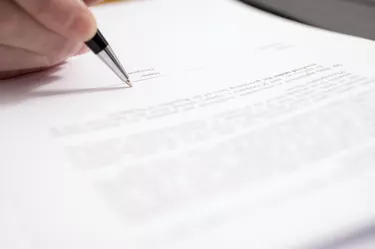
When writing a letter to the IRS, those that are properly addressed will get routed to the correct department and get a quick response. Clearly state the subject of your correspondence, identify yourself or your corporation, reference relevant IRS correspondence, state your issue(s) as numbered points and include relevant attachments — irrelevant attachments could delay your response. These guidelines address mailed letters but are equally relevant for emails or forms filled on the IRS website.
General Guidelines for Writing a Letter to the IRS
Video of the Day
According to Success Tax Relief, when writing a letter to the IRS, you should to the facts, be polite, do not adopt a confrontational tone and do not be scared. If you have not paid taxes or unknowingly withheld information, calmly state your case, offer you full and honest cooperation, and ask for a solution. If you are strapped for cash and not in a position to pay, let the IRS know and work out a payment plan that fits your budget. The agency is not out to get you if you are on the right side of the law.
Video of the Day
Before writing a letter to the IRS letter, visit the agency website. It has a knowledge database with answers to frequently asked questions, a "Contact IRS" section with useful information for mail, telephone and email correspondence, and other sections that may help resolve your issue or simplify your correspondence.
Setting up a Letter to the IRS
If you are responding to a letter from the IRS, the letter should have department information, a reference number, subject line and date. Include this information at the top of your response verbatim. Identify the relevant IRS department for your issue and include it at the top of your letter, such as "Individual Tax Payer." Next, include a subject line for your issue such as "Unable to pay delinquent taxes." Keep it concise, ideally to one line only.
Next, include your contact information starting with your Social Security Number or Tax Identification Number and your name or the name of your corporation.You can start with an anonymous "Dear Sir" or skip the salutation and directly write about your issue.
Writing the Body of the Letter
In the body of your letter, clearly state your issue(s) concisely in first-person voice, for example:
- "I am unemployed and do not have the money to pay my delinquent tax."
- Suggest a possible solution if you can, such as: "I would like to request a six-month delay. I expect to find a job within six months and believe I would be able to pay the outstanding balance."
Do not include attachments such as a severance letter or copies of tax forms already filed with the IRS. Where relevant, for example, if you want to file an amended or corrected return, attach the relevant form, filled and signed, along with relevant documents that have changed since your original filing. If your contact information has changed, include it and a phone number. The IRS often calls filers if it has questions. End your letter politely.
Make a copy of your letter and attachments for your file. If you're responding to a letter from the IRS, put the address from the notice voucher in the return envelope window; if you're using your own envelope, just write the address from the notice on it. If your letter is not a response, use the addresses listed on the IRS website that are divided by state. If you do not receive an acknowledgment or response within six weeks, contact the agency to check if they received your letter.